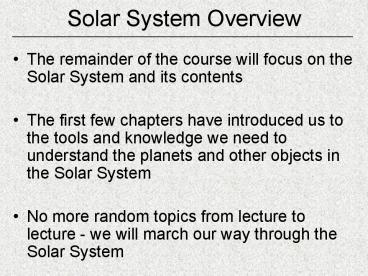Solar System Overview - PowerPoint PPT Presentation
Title:
Solar System Overview
Description:
No more random topics from lecture to lecture - we will march our way through the Solar System ... result of how they formed when the Solar System was created ... – PowerPoint PPT presentation
Number of Views:73
Avg rating:3.0/5.0
Title: Solar System Overview
1
Solar System Overview
- The remainder of the course will focus on the
Solar System and its contents - The first few chapters have introduced us to the
tools and knowledge we need to understand the
planets and other objects in the Solar System - No more random topics from lecture to lecture -
we will march our way through the Solar System
2
Inventory of the Solar System
- The Greeks knew of the Sun, the Moon, Mercury,
Venus, Mars, Jupiter, and Saturn - All these objects are visible with the naked eye
- Temporary objects like comets and meteors were
also regularly visible - The other planets and moons of the Solar System
would have to wait until the invention of the
telescope to be discovered
3
The Planets
4
Planetary Properties
- A planet's orbital period is the amount of time
it takes for the planet to complete one
revolution around the Sun - Neptune orbits the Sun at a distance of about 30
A.U. What is it's orbital period? - Remember P2 (years) a3 (A.U.)
5
Planetary Properties
- The planets of the Solar System have a wide range
of masses. For comparison, planetary masses are
usually expressed in Earth masses. - Which planet has the most mass?
- Which planet has the least mass?
6
Planetary Properties
- The size of the planets also varies widely. For
comparison, planetary radii are usually expressed
in terms of Earth's radius. - Which planet is closest in radius to the Earth?
7
Planetary Properties
- Many of the planets in the Solar System have
moons - Which planet has the most (known) moons?
- Which planets have no moons?
8
Planetary Properties
- Many of the planets have ring systems, made up of
tiny dust particles in orbit around the planet - How many planets have a ring system?
9
Planetary Properties
- Each planet also spins on its own axis, just like
the Earth. The rotation period of a planet is
usually expressed in Earth days. - Which planet has the longest rotation period?
- Which planets spin backwards (opposite the way
they rotate the Sun)?
10
Planetary Properties
- A planet's average density is calculated by
dividing its total mass by its total volume - Which planet has the highest average density in
the Solar System? - Which planet would 'float' if you could put it in
water?
11
Layout of the Solar System
12
Relative Sizes in the Solar System
13
The Terrestrial Planets
- The four innermost planets are called the
terrestrial (or earth-like) planets - Each planet in this group (Mercury, Venus, Earth,
and Mars) is very different - As a group, they stand apart from the other outer
planets - Many of their properties are a result of how they
formed when the Solar System was created
14
The Jovian Planets
- The outermost planets are called the Jovian (or
Jupiter-like) planets - Again, each planet has unique properties, but as
a group are very different from the rocky
interior planets - The Jovian worlds are very unimaginable places,
with no solid surface - Many moons of these planets are very interesting
15
Terrestrial close to the Sun closely spaced
orbits small masses small radii rocky solid
surfaces high density slow rotation few moons no
rings
Jovian far from the Sun widely spaced
orbits large masses large radii gaseous no solid
surfaces low density fast rotation lots of
moons all have rings
16
The Other 'Stuff'
- Besides the planets, the Solar System contains
millions of other smaller objects - Asteroids are concentrated around the asteroid
belt, between Mars and Jupiter - The Kuiper belt, outside the orbit of Neptune, is
home to many smaller icy objects - The Oort cloud, a shell surrounding the Solar
System, is where many of the comets we see
originate































